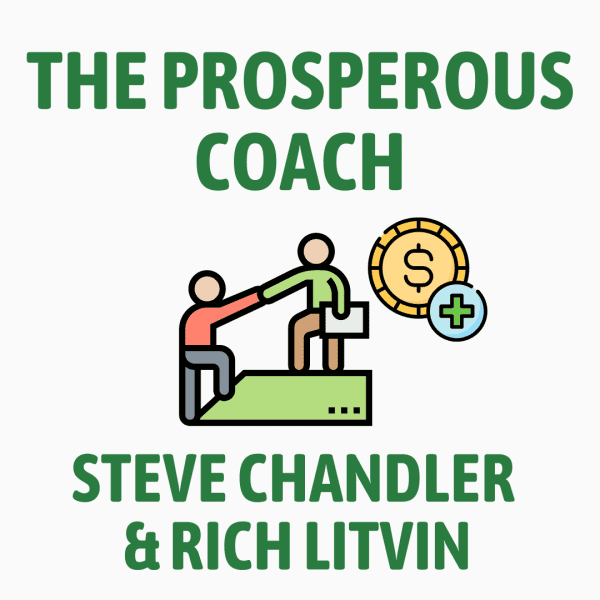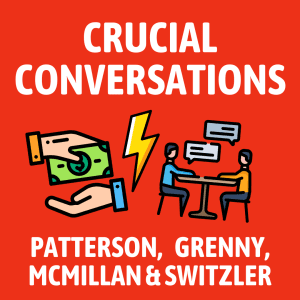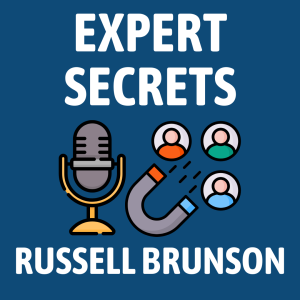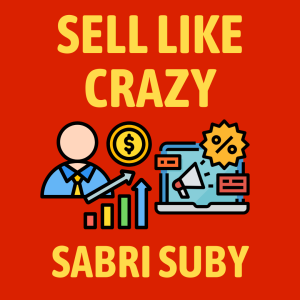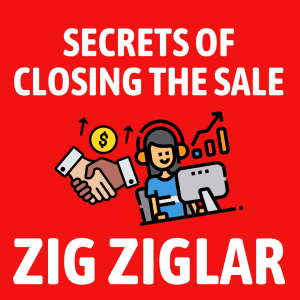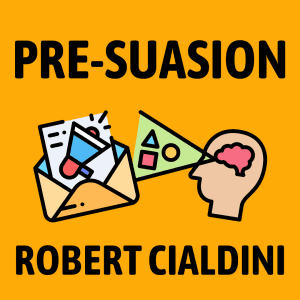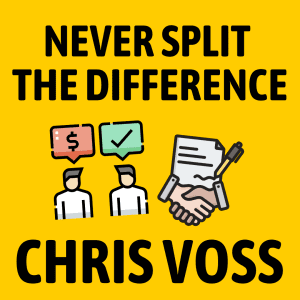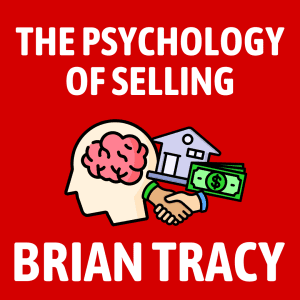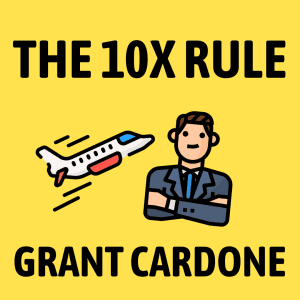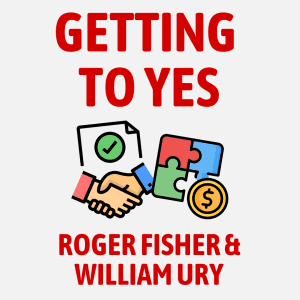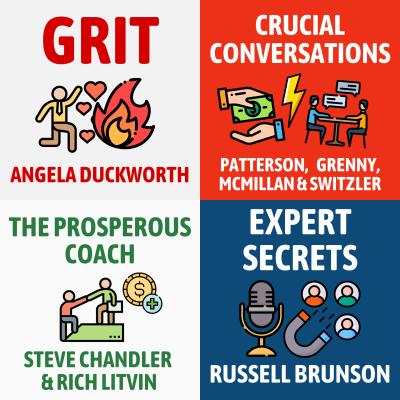If you want to help others reach their full potential, while getting paid well, then coaching may be the right career for you.
And because you’re here reading this note about The Prosperous Coach book… you’re probably already interested in starting a coaching business.
Well, good news!
Right here, right now, you’ll learn ideas and techniques that can help you succeed and prosper as a professional coach. Ideas to help you find clients, coach them deeply and charge the kinds of fees you truly deserve.
The Prosperous Coach was written by Steve Chandler and Rich Litvin.
Steve has been teaching coaches how to build a thriving practice for years through his Coaching Prosperity School. Years ago, he saw there were many schools teaching people how to become coaches, but nobody was really teaching the business side and how to get clients. He has also written dozens of books related to personal growth.
Rich Litvin was one of Steve’s best students. When he first came to Steve’s course, he had great coaching skills, but couldn’t get clients. That changed quickly after he learned Steve’s tools for creating clients. Within a couple of months, he was making tens of thousands of dollars through coaching.
(And I know that sounds unbelievable, but that’s what these guys do. They spend all day thinking about how coaches can get clients and increase their income.)
Now Steve and Rich often teach together. They specialize in showing you how to grow a successful coaching business through invitation or referral only, without business cards, networking events, email lists, social media or internet marketing. The tools in this book will work best if you want to work with a few high-paying clients.
Before we jump into the great ideas from this book, I want you to please take a moment to imagine…
What’s your ideal business lifestyle?
If you could wave a magic wand and have the coaching business of your dreams right now, what would it look like?
- How many hours per week would you work?
- How many weeks per year would you take for vacation?
- What do your clients look like?
It’s important you feel clear about what you want your business to look like. Many people become interested in starting their own business because they are sick of the 9-5 workweek.
But if you want to avoid getting stuck in another workweek you hate, then you need to define what your ideal business would look like. It’s not just about how much money you make, it’s about what kind of lifestyle your new business will enable you to live.
For example, Rich decided he only wanted to work with five one-on-one clients. And he only wanted to work three days a week. He wanted to take two months of vacation per year. He also wanted to coach by phone so he has the freedom to travel anywhere he wants. So he created his business from the beginning with that lifestyle in mind.
My own ideal business is about freedom and meaning. From the beginning I knew that I wanted to make money even when I wasn’t working. So I designed my first online business to create passive income. This means people come to my website and buy my courses even on days I’m not actively working. To me, that’s real freedom.
But let’s get back to you.
After you have an idea of what kind of coaching business you’d love, the first question you’ll probably have is:
How do I get clients?
Which takes us to the first idea of this book:
🗣️ 1. Deep Conversations: To get clients, have a deep conversation that showcases the power of coaching
Many beginner coaches are confused about what they need to do to launch their business.
And it’s no wonder! There are so many marketing gurus out there all vomiting different advice at you. Facebook marketing, Instagram, Youtube, Pinterest, paid advertising, and the list goes on and on.
All this conflicting advice makes it difficult to focus and really build your business. So let’s make this really simple…
If you wake up and check your email a dozen times, post on Facebook or Twitter, think about writing a blog post and then spend an hour tinkering with your logo or website design…
…none of that gets you clients!
Here’s a quote, (and this may be the most important quote in the book):
The kind of clients you would love to work with are only created in a conversation. And high-performing, high-paying clients are only created in impactful, life-changing coaching conversations.
Remember this advice comes from two guys who have been professional coaches for years and helped countless other people build a coaching practice.
They say you can only create clients inside of a conversation.
This means every day your number one priority is to spend as much time inside conversations as you can. The more time you spend in conversations with potential clients, the closer to your dream business you will get.
This also means you need to quit spending so much time on all the other activities that “feel” business related, but don’t really get you paying clients, like posting an inspiring quote on Facebook.
What kind of conversations?
Now, it’s important you have the right kind of conversations with potential clients.
We aren’t talking about a light chat in a cafe somewhere. Steve says that establishes a social relationship between you and your prospect, which lowers the chance they will become your client.
Steve and Rich recommend you schedule an initial conversation that lasts about 2 hours. This gives you time to really dig deep into their life situation. It gives you time to find what part of their life you can offer to help with.
You want to have conversations that give the other person a deep and impactful experience of coaching. That’s the best way to make someone realize the value of coaching. Give them a great taste of it.
The struggling coach tries to sell the concept of coaching. The pro coach sells by giving people a powerful experience of coaching.
In other words, don’t try to tell people how great coaching is. Schedule time for a real conversation and show them how great of a difference coaching will make in their life.
Rich began his coaching career by offering hundreds of free 30 minute coaching sessions for “Instant Confidence.” Within 90 days, he had done 400 of these free sessions. And while it was a great way to grow his coaching skills quickly, it was a bad approach to creating clients. These sessions were simply too short to create the long-term committed clients he was looking looking for.
[action-step]This week make your #1 priority be scheduling and having deep conversations. Every hour you spend outside of a coaching conversation is an hour you did not grow your business.[/action-step]
❓ 2. Just Ask Them: To schedule a coaching conversation, just ask if they want help
So how do you invite someone to one of these two-hour conversations?
Well, Steve and Rich share two questions you can use to turn a casual conversation into a potential client.
The first question is: Would you like some help with that? Whenever you are talking to someone and they mention one of their biggest goals, dreams or desires, then you can ask them “Would you like some help with that?” It’s a simple and direct question that can often lead to scheduling a two hour coaching session, which can lead to your next client. All because you asked one question.
The second question is: Who do you know? Here’s an example from the book using this question:
“Christina, can you help me? I have a space available on The Confident Woman’s Salon. It’s a program for nine amazing women. Each woman is powerful, confident and successful. She has already achieved a great deal in life. And despite a track record of success, she is ready for support to achieve a goal that feels ‘impossible’ right now. Do you know a woman like that?”
So this is about knowing exactly what type of client you’re looking for. Then asking the person you’re talking to if they know someone like your ideal client. And even if you think you’re now talking to your ideal client, you can still ask the question this way.
If the person tells you excitedly that they fit your profile of who you’re looking for, then it’s a perfect time to schedule a 2 hour session, to see if you’re really a fit to work together.
Or they may mention a friend that fits your description. If this is the case, then you can dig deeper into why that friend’s name popped up. What goals or challenges are they facing now? Ask the person to recommend you to their friend.
[action-step]Two magic questions you can use to set up conversations are: “Would you like some help with that?” and “Who do you know?” Make sure to slip these into your chats with new people when you see the opportunity.[/action-step]
🏆 3. Consistent Work: Coaching success requires working even when you don’t feel like working
Imagine if a construction worker called his supervisor one morning and said he wasn’t showing up to work today because he didn’t feel “motivated.”
That would be crazy!
But that’s exactly what many beginner coaches do.
What they do today depends on how they feel today. If they don’t feel great, motivated or inspired, then they don’t work on their business. Steve calls this having the professionalism of a toddler.
If you want to succeed in building your coaching practice, then you need to see your work as a blue collar job. Success at a blue-collar job is simple. The more time you work, the more money you make.
Building a coaching business can be equally simple. The more time you spend on the right activities, the more your business will grow. But you need to practice the right activities day by day, whether you feel like it or not. Even when you don’t feel like it.
This is what being a professional is about. (And it’s also what being an adult is about!)
And if you’re following your calling, then I believe you’ll find the strength to do the things you need to do to succeed.
Measure Your Work Activities
One key for this is to measure your activities. Steve says when he started measuring, to the minute, how much time he spent every day really working, working on getting into conversations, his business skyrocketed.
That’s because a lot of the time you think you spend working, you actually waste doing unprofitable activities like checking email, reading Facebook, etc.
The business guru Peter Drucker famously said: “What gets measured, gets managed.”
Awareness is the first step. Becoming fully aware of how much time you spend doing the activities that actually grow your business is the first step. Soon you will naturally focus more and more time on these activities, and your business will grow faster.
[action-step]Create a spreadsheet that tracks how many people you connected with this week, how many you invited to a coaching conversation, how many you sat down with for a 2-hour conversation and finally how much money you asked for in coaching fees this week. (This is an exercise Steve’s coaching clients must email him weekly.)[/action-step]
📚 4. Body of Work: Create a body of work that brings clients to you, including articles, speeches, books, etc.
Now there is probably a big question burning in your mind:
How do you find people to invite to conversations? They aren’t going to fall out of the sky, after all.
First, Steve and Rich don’t recommend cold calling. Calling strangers to sell them coaching when they don’t know you and you don’t know much about them is usually a waste of time.
Cold emails are also bad. Most people’s inbox is crowded and busy. If you send a long email explaining how your coaching could help someone, Steve says “it will not arrive in the same spirit in which it was sent.” What he means is the noisy inbox is not the right environment to communicate about coaching.
You will increase your business tenfold if you respond to almost every prospect’s long email with the words, “Call me.”
So how do you meet potential clients?
One way is meeting new people in-person. Steve and Rich recommend you first put yourself into a mindset of giving instead of taking, then go and connect with people. Your mindset is important because when you are genuinely interested in how someone’s life is going and what direction it is headed, then you will eventually see some project or challenge that you may be able to support them with.
You can also start by reconnecting with people you already know, like old friends or colleagues. Ask about their life in a genuine way. Or you can go to a social event and initiate contact with people that way.
You can also develop your own intellectual property and a body of work. This is obviously a long-term strategy. Steve Chandler has written dozens of books, on everything from time management to business. Some of the people who read your book will reach out to you, and you can use the opportunity to schedule a conversation.
Also, just the fact that you have written a book will instantly make people see you as an expert. This makes it easier for you to charge higher fees, get speaking engagements and be seen as an authority by your potential clients.
I got the impression Steve and Rich create many of their clients from their speaking. They often speak in front of groups. There will often be someone impressed with their message who will later contact them interested in one-on-one coaching. They will quickly schedule a one-on-one conversation while the enthusiasm is high.
You can’t write a book? No worries! The internet has opened up so many other channels for you to start publishing your thoughts and advice where other people can find it. You can write articles, interview people or get interviewed on podcasts, start a Youtube channel. Just pick the method that resonates best with you and start publishing today.
(I personally love writing. That’s why both of my businesses have been centered around attracting people through writing.)
[action-step]Decide which online channel is the best fit for you. Is it blogging, podcasting or starting a Youtube channel? It all depends on your personal strengths and personality. Then plan out your first piece of content that will attract and help your target client.[/action-step]
🔍 5. Personal Transformation: Create personal transformation by helping them uncover what they really, truly want
If you’re a coach, then your job is really to make a difference in someone’s life. It’s amazing if you think about it. It’s a great privilege to be a coach, but it’s not an easy job. So right now we’ll talk about how you can coach more effectively.
How do you really connect with someone in a 2-hour conversation so they feel transformed by the experience and want to hire you?
Steve and Rich say the most important thing is to find the goal underneath their goal. To explain what this means, here’s another quote:
The real magic is in whether you are willing to help your clients dive deeper than they have ever gone into the question: What do you really, really, really, really want? Show up. Be present. Be bold. Coach them powerfully. Be relentless. Be Sherlock Holmes and explore deeper into their lives than anyone has ever gone with them. (…)
When I meet someone interested in coaching, I ask them to tell me about their dreams. And then I help them to dream bigger than they have ever dreamed before. Then I help them see a way they can really, truly create that dream in their life.
You can feel how passionate Steve and Rich are about coaching. They truly believe it can have a life-changing impact in someone’s life. And their energy comes through so well in their writing.
In your first coaching session with someone, the most important thing is for you to find out what they really want.
This may not be what they tell you in the beginning. People are always putting up a social mask, especially when they meet someone new. So the first time you talk to a client, they may present you with a goal that isn’t really what they want, but what they feel they should want… according to their parents, coworkers, society, etc.
So you will need to dig to find what their real goal is, what Steve calls “the goal behind their goal.”
For example, a business owner may come to you with a goal of selling their business for 10 million dollars. At first glance, it looks like their goal is becoming filthy rich. But maybe you dig some more and ask why they want the 10 million dollars. And then you find out they work 100 hours per week now on their business, leaving them no time for family, hobbies or relaxation. And the only way out they can see is to sell their business.
So the real goal isn’t the 10 million, it’s freedom to spend time on other things that matter in their life.
When you find their real goal, you may be able to give them a shortcut to reach it much sooner. For example, you could show the business owner how to hire and train a manager which frees up much of their time.
One way to find their deeper goals is by repeatedly asking: “What else?” With a business owner you could ask, “Once you have the 10 million dollars, what else do you want?” This will lead you deeper into what the person most deeply desires. So remember to ask “What else? What else? And what else?”
[action-step]Next time you’re in a coaching conversation, ask the person what their goals are. But don’t be satisfied by their first answer. Ask “why?” and “what else?” until you have uncovered their deepest goals and true motivations.[/action-step]
😊 6. Your Success Stories: Eliminate your self-doubt by collecting your coaching success stories
A lot of beginner coaches have self-doubt. They are always questioning if they are good enough. This lack of confidence transfers to people they talk to, which makes it hard for them to get clients.
But Steve says it doesn’t matter if you feel worthy or unworthy. You just need to talk about facts and real-life stories that demonstrate your coaching successes. Tell stories in a matter of fact way about how your client achieved an important goal or overcame a problem in their life. If something is a fact that happened, then you can easily talk about it with absolute certainty and confidence. You don’t need to “believe in yourself” to do this.
This is not about bragging. This is about making your client’s decision to work with you easy. Think about it. If someone just met you and wants to work with you, they first need to know that you have the skills to coach people. So you just share what you and your clients have done in the past. People don’t want to work with someone who is shy, meek and humble. They want to work with someone who will help them get what they want. And past client stories prove you have the skills to make a difference in their life.
Casually insert them into the conversation as an example of an idea that you’re talking about. Steve and Rich do this constantly in this book. After talking about an idea, they tell the story of how one of their clients used that idea to be more successful. This both proves their idea works and it makes you see them as credible experts who know what they’re talking about. (In case you haven’t figured it out, this book is one way they can attract and sell themselves to their potential clients.)
[action-step]Make sure you keep a record whenever you get an email or call from someone thanking you for your work. Write down when a client hits an important goal. Read over this list before your coaching conversations to remind yourself of who you are. And most importantly share the stories with potential clients, casually slipping them into the conversation.[/action-step]
🛠️ 7. Solve Real Problems: You only get paid by helping someone solve a real problem or achieve a concrete goal
When you first learned about professional coaching, did you feel surprised that people might actually pay just to talk to you? Well, the truth is people don’t pay to talk to you.
They will pay IF they believe talking to you will let them solve some problem in their life or achieve some concrete goal.
And this is where many beginner coaches go wrong. They lose sight of the problems and goals the person sitting in front of them has, and they start “selling coaching.” They start talking about how many hours of coaching there will be, how many times per week their client can email them, what kind of information the client will get, they talk about what style of coaching they practice. This is all about YOU and not about what the client cares about.
Steve Chandler says the biggest mistake coaches make is:
They don’t honor the person they are selling to. They place their own needs and fears ahead of the prospect’s. They don’t enter the prospect’s life and solve a real problem.
That’s the reason he recommends your initial session with a client be 2 hours long. That’s enough time to really dig into their world. That’s enough time to make someone feel comfortable sharing some of their true hopes, fears, and frustrations with you. That’s enough time to see where you have an opportunity to make a real difference and transformation in this person’s life.
Coaching is not about “information.” It is about transformation. Change someone’s life and they will hire you. All other activities are weak-kneed and wimpy and will have you quit this profession in absolute despair.
How much money can you make as a coach?
The truth is, there is no set price. It’s not like most careers where your salary based on your education and years of experience.
You can make as much money as people are willing to pay you.
For example, if someone believes that your $5,000 coaching will help them earn an extra $10,000 this year, then why wouldn’t they pay you that much money? They’re getting a great return on investment. (Many coaches used as examples in this book make six figures or more by selling their coaching as a way to increase your income or grow your business.)
The famous self-help guru Tony Robbins has a few coaching clients he charges ONE MILLION DOLLARS per year. He can do that because he’s a world-famous celebrity at this point, and his clients are world-class athletes, movie stars, CEOs, etc.
But most coaches don’t make that much. One study found that 80% make less than $20,000 per year. Also, most coaches only work part-time, probably having another job or spouse to help support them.
The point is, your value as a coach is not set in stone. There really is no standard “hourly rate” for coaches because each one might specialize in helping people solve a different problem. Your fees really depend on how big of a transformation you can make in your client’s life.
As the billionaire Elon Musk says is: “You get paid in proportion to the difficulty of the problem you solve.”
[action-step]When talking to clients, always keep the focus on what the problem in their life is and what important goals or dreams they want. People only pay for coaching when they believe coaching will improve their life in some concrete way.[/action-step]
💸 8. Value Perception: People who “can’t afford your fees” really just don’t want your coaching bad enough
What if someone is interested in your coaching, but it doesn’t look like they will be able to pay you the fees you want?
Here’s a quick personal story. For years I wanted a Leica camera. Leica is a legendary brand in the camera world. Their cameras are beautiful, minimalistic and very very expensive. And for years I told myself that spending thousands of dollars on a camera was a foolish thing to do. But whenever I saw a photo of a Leica I would lust after it until one day I gave in. I bought a used Leica camera and lens from eBay. I can’t say my photography is any better really, but the camera is a joy to use.
And the point of this story is that most people can remember a similar time in their life. A time when you wanted something so badly that you found a way to get the money even though you couldn’t “afford” it. Maybe it was your first car, a fancy camera or a beautiful dress for prom.
People can usually find the money for what they really desire. When they really want something, then suddenly they can find the resources.
Steve has coached a few people who looked like they didn’t have many resources, but after experiencing the powerful benefits of coaching firsthand, they found a way to get the money. Borrowing from a relative, selling things they didn’t need, taking a few extra work shifts, and so on.
So when someone tells you they can’t afford your fees, what that usually means is they don’t want your coaching enough. Perhaps you didn’t give them a powerful enough experience in the conversation. Perhaps you didn’t dig deep enough into their life goals and problems.
Picasso’s napkin
It’s usually a mistake to lower your fees in a hope to sign up another client. If someone complains that your hourly fees are too high, you must make them remember that they are not paying for an hour of your time.
They are paying for skills that have taken you years to develop. They are paying for your accumulated wisdom and knowledge you’ve gathered from all the books you’ve read, courses you’ve attended and the personal development work you’ve done yourself. That is a lifetime of work.
There’s a great story shared in The Prosperous Coach about Picasso the famous painter…
One day Picasso was sitting at a cafe. He drew a small sketch on a napkin.
A lady recognized him. Excited, she asked how much she could pay for the napkin.
Picasso said $20,000.
The lady was shocked. She said, “But it only took you two minutes to draw.”
And Picasso replied, “No, it took me my whole life.”
Wow, now there’s a profound new perspective.
It took Picasso a lifetime of work for him to become Picasso. He was one of the most prolific painters that ever lived, creating tens of thousands of artworks. And he spent decades creating a world-famous brand that now makes his art worth millions of dollars.
[action-step]Don’t lower your fees if someone says they can’t afford it. What it usually means is you didn’t do a good job demonstrating the concrete difference your coaching will make in their life.[/action-step]
🔄 9. Emphasize Their Outcome: At the end, refocus on what they want to secure commitment
Imagine you connected with someone and invited them to a two-hour conversation. It’s going well. You explored their life deeply and found some area you can help.
Now, how can you close the conversation so they sign up as your client?
This is a tricky moment. Many beginner coaches make mistakes here. They become awkward, they sell too hard or they forget to ask the person to sign up as a client.
The good news is, Steve and Rich have been signing up coaching clients for years and they have a couple big tips for you.
Think about the last time you bought a car. How did your conversation with the salesperson end? Probably by talking about price. People are conditioned to talk about price at the end of a business-related conversation.
But you’re not selling a car. You’re selling transformation.
That’s why at the end of the conversation you always want to focus their attention back to the positive vision of what their future could look like.
Here are a few questions Steve and Rich use:
What’s possible for us? What would you like to change? What do you want? Why don’t you have it now?
Tell me what you want and then tell me why it is not in your life right now. If you can tell me why it’s not in your life right now, you and I might be able to create a plan to work together to make that possible for you.
What would that be worth to you? Would those results be worth that investment? You tell me. I’m not going to tell you.
You want the person to focus on how they want their life to change, not on how much you charge. And you want them to tell you in their own words what they imagine a better future to be, and what that future is worth to them. By doing this, the potential client stops worrying about cost and starts to feel their ideal life is possible because they can see it in front of them.
The next thing you must do is lead the conversation. Never expect someone to take the initiative signing themselves up to be your client.
They have come to you to be coached. And part of being a coach is leading. This means it’s your job to direct the conversation where you want it to go. This doesn’t mean you have to be pushy. Steve recommends you ask an innocent question at the end of your coaching session like “Is this something you would like to do?”
If they assure you they are serious about being your client, then you can lead them more. Get them to write down the time and date on the calendar for your second coaching session. Tell them where and how they can make their payment.
[action-step]At the end of the conversation, don’t focus on price. Ask them questions about what they want and why. Finally, you must lead them by asking directly if they want to sign up as your client. [/action-step]
🎁 10. Offer Value Every Time: Always offer some value when you contact a potential client again
What if someone shows interest in your coaching, but they say they need time to “think about it” or talk about the decision with their partner? How should you follow up with them later?
When you contact potential clients again, don’t do it just to and see if they have made up their mind yet. That will make people feel an uncomfortable pressure because now they have to think of some way to gently make you go away. Everyone hates needing to reject someone.
Here’s what Steve and Rich recommend you do instead:
If you haven’t heard back, send a gift and a note. Don’t even refer to working together. Contribute and serve. You don’t need them; they need you. Behave accordingly.
So if you contact people again after the coaching conversation, always offer some kind of value like a new idea, story or recommendation. This lets you stay in touch without people feeling uncomfortable pressure.
Remember that the relationship between a coach and client is usually a long-term and intimate relationship. That’s something people may not feel comfortable jumping into right away. But if you stay in touch with your potential clients (always offering value when you contact them), then a few months or a year down the line they may be ready to sign up as your client.
Not being needy is so important because people want what they can’t have, and they run away from things that chase them. It’s just part of human nature that limitation and scarcity are valuable. People want things that are a little out of their reach. That’s why many people dream about Lamborghini cars or Luis Vitton handbags. That’s why it’s better your clients feel that you want them but you don’t need them.
[action-step]Don’t email someone just to check if they have decided to be your client. Always email them offering some value, like an idea, anecdote or recommendation.[/action-step]
Conclusion
I know you’ve learned a lot from this very practical book about how to become a successful coach. This is a note that I’m sure you’ll come back to again if you’re interested in running a coaching business. And every time you come back here, the ideas will sink in a little deeper.
Of course, if you enjoyed this note, then I recommend you pick up the full book. There are a lot more ideas in there that I wasn’t able to fit into this summary.
If you’re just thinking about starting your business, then I recommend you check out my note on “Will It Fly?” by Pat Flynn. That book will show you a process to test if your business idea is a good one… before you sink a lot of time and money into it.

